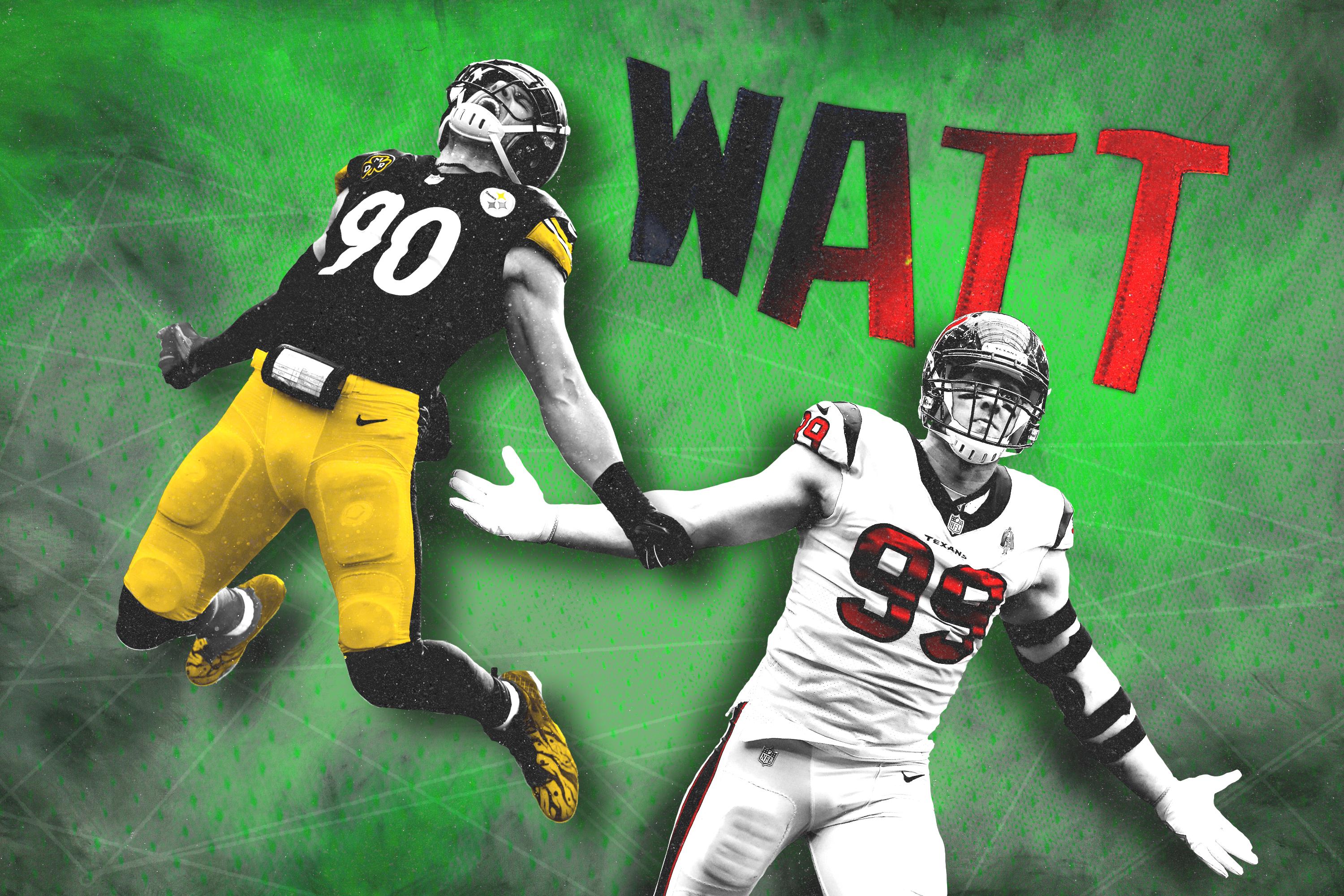
After missing most of the past two seasons with back and leg injuries, Texans superstar pass rusher J.J. Watt is officially back. Watt won the AFC Defensive Player of the Month award for September and, through five weeks, he’s tied for the league lead in sacks (six) and forced fumbles (four). But the three-time Defensive Player of the Year has some competition at the top of the defensive stat sheets: his younger brother T.J., who plays outside linebacker for the Steelers. Their numbers so far this year are nearly identical:
While those traditional stat lines match up nicely—as does the fact that both brothers primarily play on the left side of the defensive line, and both play with nonstop motors—the 29-year-old Texan and 23-year-old Steeler are not the same player; they each bring unique skill sets and varying levels of experience to their respective teams. But they’re both still measured on the same success scale, and that largely centers on getting into opposing backfields to wreak havoc.
So which Watt brother is winning the battle for NFL pass-rush domination? To answer that, I dug in to their tape.
Let’s get the obvious out of the way: J.J. Watt plays a different position than his younger brother. Sure, both Watt brothers are pass rushers, but T.J. lines up mostly in a two-point stance at the outside linebacker spot in Pittsburgh’s scheme while J.J. alternates between defensive end and the three- or four-technique positions in Houston’s system, mostly playing out of three- or four-point stances. T.J. is asked to drop back into coverage at times; J.J. rarely ever does. J.J.’s also substantially bigger than his brother, and is listed at an inch taller (6-foot-5 vs. 6-foot-4) and about 40 pounds heavier (288 pounds vs. 252 pounds)—so right off the bat, it’s a bit of an apples-to-oranges comparison.
Still, despite that size difference, J.J. doesn’t give up any speed or explosiveness, and he’s able to generate more power in his pass rush. If he gets his hands into an opposing tackle’s chest plate, it’s over immediately—he’ll run right through a guy, like he did in Week 4 against Colts tackle Denzelle Good:
Or he’ll use that leverage to quickly swipe at an offensive lineman’s arms, disrupting his opponent’s balance so he can whip right past. He used this move on Giants right tackle Chad Wheeler in Week 3.
J.J. also has the edge over his brother in versatility, and he frequently slices through offensive lines from interior alignments. In those close confines, his combination of length and power makes him extremely hard to deal with, both as a pass rusher ...
… and as a penetrating run defender.
Despite the injuries J.J. Watt has dealt with through the past few years, the elder Watt still boasts a top-tier get-off at the snap, and is able to shoot out of his stance and get upfield in the blink of an eye. I mean, as a tackle, how do you prepare for a defensive end who can go right through you or get around you on any given play?
T.J. has an advantage in his elite closing speed, which has already shown up on a few occasions in his second year. If he gets the corner on a tackle, he’ll explode into the pocket and chase down pretty much any opposing QB. He demonstrated that Sunday when he closed the gap and brought down Matt Ryan for a huge loss in the second quarter. This was on a bootleg to the other side of the field!
At times, T.J. has also shown that he can convert his speed to power. Against the Falcons, he caught veteran tackle Ryan Schraeder off-balance and bull-rushed through him, nearly creating a sack.
The younger Watt’s athleticism constantly shows up on tape, whether he’s chasing down a play from the backside, disrupting throwing lanes with well-timed leaps, or tracking down opposing passers. And while he’s still working on his repertoire of pass-rush moves, that pure hustle has helped him pick up a few hurries and sacks this year.
But even though the Watts’ styles and defensive roles vary, they’ve gotten the job done this year in just about every metric. They’ve each notched six sacks (tied for first in the NFL, along with Geno Atkins) and seven tackles for a loss (tied for fourth). J.J. has racked up 23 pressures on the year (tied for seventh), per Pro Football Focus, including six quarterback hits and 10 hurries, and 17 stops (fourth among edge defenders and interior defensive linemen), which PFF defines as tackles that constitute an “unsuccessful” play for the offense; T.J.’s not far behind, with 20 total pressures (tied for 18th), including six hits and eight hurries, and he leads all edge players and interior defensive linemen with 19 stops.
Tape from the first five weeks shows the brothers have developed some pretty eerie similarities in play. Both are aggressive against the run and always aware of where the ball carrier is in the backfield, and they’ve each grabbed nearly identical shoestring tackles for loss.
It’s a bad idea to use a tight end to block either Watt brother …
… And both players display that requisite “bend” around the edge, or the ability to turn the corner that all elite pass rushers possess.
So far this season, J.J. has shown himself to be the more complete pass rusher and all-around player out of the Watt brothers. He boasts an exceedingly rare combination of defensive-tackle-like size with the speed and agility to rush off the edge. His power and quickness allow him to line up anywhere on Houston’s front; he’s savvy, technically sound, and he’s got a refined pass-rush plan. As long as he can stay healthy, I expect he’ll contend for his fourth Defensive Player of the Year award this season.
Still, T.J. is on the verge of his own breakout. J.J. grabbed 5.5 sacks in his rookie year before busting out for 20.5 in his sophomore campaign, and after five weeks, T.J. is on pace for 19 in his second year. He needs to show a little more consistency—those sacks have tended to come in bunches, and he’s disappeared in some stretches—but T.J. has proved that his rookie campaign, when he notched seven sacks, 40 pressures, 30 stops, a forced fumble, and seven pass breakups, was no fluke. J.J. may have the edge this year, but both have been wildly successful at their ultimate goal: making life hard for opposing quarterbacks.

